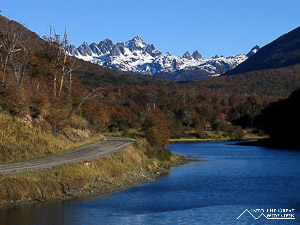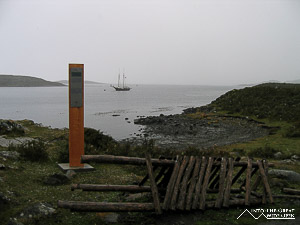Puerto Williams, Chile
At the End of the Americas
April 24, 2008
Won't be the last
Won't be the first
Find a way to where the sky meets the Earth
It's alright and all wrong
For me it begins at the end of the road
- Eddie Vedder

After four and a half months of continuously traveling south I had finally reached the end of the road, literally. Puerto Williams has a population of about 2,500 people, with 800 or so affiliated with the naval base located in the city. If you call 2,500 people a city then I suppose Puerto Williams is the world´s southernmost city, otherwise Ushuaia, just across the water in Argentina, with around 50,000 people holds that title. On Isla Navarino where Puerto Williams is located there is actually a town called Puerto Toro with 50 inhabitants, accessible only by sea, which is the world´s southernmost permanent settlement.
Puerto Williams is amazingly isolated despite only being located a few dozen miles from Ushuaia. The only way supplies arrive is on the ferry from Punta Arenas that brings in all the fresh fruits and vegetables every Friday and takes back all the trash and recyclables when it returns every Saturday. Otherwise there is one daily flight from Punta Arenas and possibly a flight every other day in a 4-person plane from Ushuaia. It is also possible to cross to Ushuaia from Puerto Navarino, the port across the Beagle Channel from Ushuaia, in a raft with an outboard motor once a day. As the woman who owns the hostel I stayed at liked to say, "It´s easy to arrive but difficult to leave," something I would later discover was very true.

The island itself is very pretty with large tracts of untouched wilderness with miles and miles of hiking trails in varying states. There is 5-day circuit called the Dientes (Teeth) de Navarino that winds around some beautiful mountain scenery and remote lakes. Unfortunately as it was the beginning stages of winter and not having a tent or suitable sleeping bag I decided to do only the first day of the circuit. This consisted of climbing to the top of Cerro Bandero and then continuing onward to the first series of lakes before returning back to town along the river. The trail to the top of the hill was easy enough to follow, though rather steep the entire way. The views from the top were amazing with the windblown and snow-covered summit overlooking the town below and views across the Beagle Channel to the mountains of Argentine Tierra del Fuego glowing orange from the low angle of the sun. From the top the trail was not well marked but I had the trail notes and contour maps so I knew that it followed the mountainside between the ridgeline and the tree line.
The trail, or its general trajectory, would have been easy to follow in theory but the snow accumulation and cold temperatures meant that I would take one step and the icy snow might hold my weight while with the next step I would plunge knee-deep or even hip-deep into the snow as this fragile layer of frozen snow gave way. This made for very slow going and I quickly had freezing cold snow and ice inside my boots and pants. After about an hour I abandoned the trail and decided to head straight downhill towards the lake where I could pick up the return trail along the river. This took some time as the snow covered mossy slopes were extremely slippery but I was able to make it to the lake and enjoy the picturesque views of the jagged Dientes de Navarino. There were lots of dead trees around the lake as a result of the beavers that were introduced to the island back in the 1940s and are now destroying and altering the islands natural habitat with their tree cutting and dam building. The return trail along the river was very muddy and traversed a boggy area for about an hour before returning to some drier forested areas on the route back to town. Some day I would like to come back in season and hike the whole circuit but this would definitely have to be in the late spring, summer, or early fall.

The following day I walked up the road that heads east of town past Villa Ukika. This small village is home to 50 of the last 70 descendants of the Yamana people, including the last surviving fluent speaker of the language. The desolate road continued on past nice scenery and then branched off towards the coast where it ended at a gated house and fenced off section of the beach that led onward around the bay to a small lighthouse overlooking the point. In the afternoon the wind came in so I took shelter inside for the rest of the day.
On Monday I went to the newly renovated museum in town that had an extensive, perhaps overly extensive, amount of information on the indigenous people of the island, the Yamanas, and on the history of the area since its discovery around 1520. I stopped by the yacht club as well to see if there were any boats heading to Ushuaia that I might be able to get a ride with. At the moment there was only one boat in harbor and they were actually going to Ushuaia for a few days to resupply before leaving for the Falkland Islands, but they weren´t planning to leave until Friday at the earliest, if the weather held out. That night and the next I ended up hanging out in the yacht with the two guys from the boat and also with two Dutch couples that had recently sailed into port. One Dutch man told us that everyone names their boat after their wife but that if you get divorced, as had happened to him twice before, that you have to change the name of your boat. So, he named his boat, New Love in English, because that way, he said, you never have to change the name. The sailors were discussing a Japanese man that recently had tried to sail solo around Cape Horn and had sailed right into a storm with 120 mph winds and seas to 80 feet that broke both of his boat’s masts and caused his boat to start taking on water. He set off his emergency beacon and luckily the Chilean navy found him with a rescue plane and a fishing boat was then able to pick him up. There are some pretty rough seas and weather down in this part of the world, justifying the multitude of shipwrecks off these coasts. I also got feast on a kilogram of very tasty centolla (king crab) that I bought and in addition to all this king crab I got to eat plenty of centollon (snow crab) fresh off the fishing boats and still alive and moving.

Not wanting to wait for the sailboat to leave at the end of the week my only option for transport to Ushuaia was to cross with Ushuaia Boating, which considering the short distance involved, oddly cost more than flying back to Punta Arenas. On Tuesday, after waiting most of the day, I was scheduled to leave at some point in the afternoon when the winds kicked up and bad weather rolled resulting in the Navy closing the port. By the time the port reopened it was too dark to cross since the boat, or large raft, has no lights, so I was stuck in Puerto Williams for another day. On Wednesday, the weather looked good in the morning, I paid the money and the driver said that he would be back in 20 minutes or so. I waited for almost 2 hours before he returned to say that even though the weather in Puerto Williams looked good all was not well in Puerto Navarino and the port there was closed, however it might reopen in the afternoon. This never happened and so I was forced to stay yet another night.
Thursday morning I awoke to snow squalls and little visibility but the wind had at least died down considerably even if it was freezing cold with a forecasted high barely above freezing of 2 Celsius. Finally I received word that they would come by around noon to pick me up and it appeared that I would actually be able to leave this time. Sure enough the driver came at noon and we made the one-hour journey to Puerto Navarino over a very rough road and then waited for the little raft to arrive from Ushuaia with its lone passenger. The immigration officer, who was just one of the police officers from Puerto Williams had to physically travel with me in the van to Puerto Navarino to witness the arrival and departure of passengers to and from Ushuaia and then process the paperwork and stamp the passports.

After getting an exit stamp, myself and the only other passenger, a man from Puerto Williams crossing to Argentina to see his girlfriend in Rio Grande, who had paid for him to cross, a fact that greatly impressed the Argentine immigration officers, put on our lifejackets and got into the raft. It was still snowing as we left with the 150hp motor of the raft zooming us across the rough waters of the Beagle Channel towards Ushuaia. The raft would climb up one wave before slamming down into the trough, a motion repeated constantly during the 25-minute journey. We finally arrived in Ushuaia but the port was closed due to a strike so we had to get back into the boat and motor around to the yacht club where we could dock and have the immigration officials transport us over to the port. After processing the paperwork and stamping our passports they were nice enough to drive the two of us back into town and even dropped me off at the hostel that I was planning to stay at. What service!
With this short hop across the Beagle Channel I have reversed course and the long journey northward has begun. Hopefully the next few months of traveling will be as enjoyable as the first and I´ll be able to find my way safely home as I zigzag my way through Argentina, Uruguay, Brazil, Paraguay, Bolivia, and Venezuela.


















































































